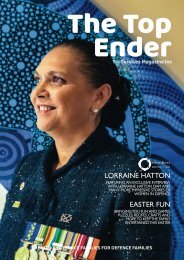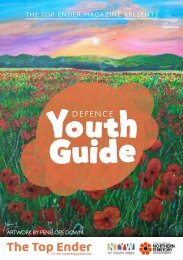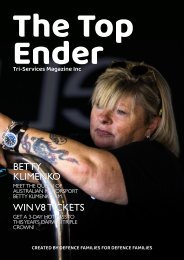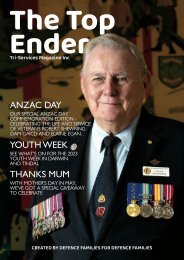The Top Ender Magazine August September 2023 Edition
This edition of The Top Ender Magazine includes competitions, feature interviews, support articles and more. We had the honour to interview Keith Payne, VC AM, the last living recipient of the original Imperial Victoria Cross. We also commemorate significant historical events and acknowledge current events like the Legacy Centenary. Find help and resources that support you to make the most out of your time in the top end of Australia, servicing Darwin, Katherine, Tindal and Pilbara regions.
This edition of The Top Ender Magazine includes competitions, feature interviews, support articles and more. We had the honour to interview Keith Payne, VC AM, the last living recipient of the original Imperial Victoria Cross. We also commemorate significant historical events and acknowledge current events like the Legacy Centenary. Find help and resources that support you to make the most out of your time in the top end of Australia, servicing Darwin, Katherine, Tindal and Pilbara regions.
You also want an ePaper? Increase the reach of your titles
YUMPU automatically turns print PDFs into web optimized ePapers that Google loves.
WE REMEMBER<br />
DAMIEN PARER<br />
Damien Parer is Australia's best known war<br />
cameraman... His film Kokoda Front Line won<br />
an Oscar in 1943.<br />
<strong>The</strong> documentary was made by celebrated war<br />
correspondent and cameraperson, Damien Peter Parer,<br />
and film-maker, Kenneth George Hall. It was filmed on<br />
location in New Guinea in 1942. In the documentary, we<br />
see Australian troops along the Kokoda Track, the fighting<br />
conditions in the jungle, and the help of indigenous<br />
carriers to remove wounded soldiers from the front line<br />
- it was one of 4 winners of the 15th Academy Awards<br />
for best documentary, and the first Australian film to win<br />
an Oscar.<br />
Damien Peter Parer was born in Melbourne on 1 <strong>August</strong><br />
1912. As a small boy he wished to become a photographer<br />
or a film-maker. Prior to World War II he moved to Sydney<br />
where he found employment with the film director<br />
Charles Chauvel.<br />
In 1940 Parer became an official war photographer. He<br />
went to the Middle East and filmed the Australians at war<br />
in Greece and North Africa. He returned to Australia in<br />
1942.<br />
Parer's next assignment was on the Kokoda track. Parer<br />
had to abandon much of his equipment, however he<br />
retained the rolls of film he had shot, and they became the<br />
basis for the Kokoda Front Line documentary. For the first<br />
time, the film showed Australians at home what conditions<br />
were like for soldiers along the track.<br />
Later, Parer filmed the fighting at Timor and Salamaua and<br />
flew in Australian Beaufighters to record the Battle of the<br />
Bismarck Sea. Parer's film can be seen in the Cinesound<br />
newsreels Men of Timor, <strong>The</strong> Bismarck Convoy Smashed<br />
and Assault on Salamaua.<br />
Image: Informal portrait of Damien Parer about to<br />
embark on the transport ship Empress of Japan. Parer<br />
was an official military photographer and cameraman<br />
with the Department of Information Film Unit. He<br />
served in the Middle East, Greece and the South-West<br />
Pacific from 1940 until his resignation in <strong>August</strong> 1943 to<br />
join the staff of Paramount Pictures Film Services. He<br />
was killed on Peleliu Island 17 <strong>September</strong> 1944 while<br />
filming front line operations with the US Marine Corps.<br />
AWM 000401<br />
140 Years<br />
On the Inside<br />
I recently visited the historic Fannie Bay Gaol (the Darwin Gaol from 20/9/1883 –<br />
1/9/1979), located at Fannie Bay, opposite the Cool Spot Café. It is now a museum<br />
where you can walk through old cell blocks and the execution gallows. It is open from<br />
10am – 2pm Wed – Sun and takes a good hour or two to see everything and read some<br />
of the stories on the walls.<br />
Entry is FREE, though donations are appreciated (please<br />
note that currently, they only have the ability to accept<br />
cash donations).<br />
Make sure you pick up their brochure at the front desk<br />
(manned by a friendly staff member), to give you extra<br />
information about what you are seeing and helps you<br />
find your way around the gaol.<br />
I highly recommend a visit to experience some of<br />
Darwin’s history - it was awesome to be able to walk<br />
through the various buildings and imagine life as it was<br />
back then for those behind bars.<br />
Written by Masela Draper<br />
Community Contributor<br />
<strong>The</strong> <strong>Top</strong> <strong>Ender</strong> <strong>Magazine</strong><br />
Her Majesty's Gaol and Labour Prison was<br />
Darwin's main prison from 20 <strong>September</strong><br />
1883 until 1 <strong>September</strong> 1979. In 1979<br />
prisoners were relocated to the correctional<br />
facility located in Berrimah.<br />
In <strong>August</strong> 1943, he left the Department of Information and<br />
took a post with the American company Paramount News.<br />
His first assignment was filming the United States Army Air<br />
Force in action in New Guinea, then returned to Australian<br />
in 1944.<br />
His next assignment was with the United States Marines.<br />
He landed with them on Guam and Peleliu. Parer believed<br />
that to capture images of the faces of men in battle it<br />
was necessary to be close to the front line, sometimes<br />
even in front of it. On 17 <strong>September</strong> 1944, he was filming<br />
marines advancing with his back to the enemy, and he was<br />
killed by Japanese fire.<br />
Image: Official photographer Damien Parer putting a<br />
new film into his Speed Graphic camera. AWM 141248<br />
Extracted from DVA<br />
anzacportal.dva.gov.au/wars-and-missions/<br />
kokoda-track-1942-1943/kokoda-track/<br />
about-kokoda-track-1942-and-today/<br />
damien-parer<br />
<strong>The</strong> 20th of <strong>September</strong> <strong>2023</strong> marks 140 years since<br />
the Fannie Bay Gaol was opened.<br />
Male and female prisoners were held in separate<br />
buildings from 1928. <strong>The</strong> female prison block included a<br />
small garden designed to keep the prisoners busy. An<br />
infirmary was added in 1887, which contained gallows<br />
used up until the last executions held in the Northern<br />
Territory in 1952. A watch tower, "native section" for<br />
Aboriginal prisoners, kitchen mess building, remand<br />
section and two maximum security wings were added<br />
during the 1950s.<br />
Written by MAGNT<br />
www.magnt.net.au/fannie-bay-gaol<br />
Cnr East Point Rd & Ross Smith Ave, Fannie<br />
Bay, Darwin<br />
Open Wed – Sun: 10am – 2pmFREE ENTRY<br />
P +61 8 8941 3650<br />
E info@magnt.net.au<br />
Closed New Year's Day, Good Friday, Christmas<br />
Day and Boxing Day<br />
14 <strong>The</strong> <strong>Top</strong> <strong>Ender</strong> | Tri-Services <strong>Magazine</strong> Incorporated AUGUST/SEPTEMBER <strong>2023</strong> 15

















